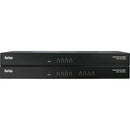Description
The Raritan MasterConsole Digital Dual (MCD-DUAL) is the ultimate dual-head Cat5 KVM switch built for the modern data center, server room, and enterprise workspace. Engineered for a single operator to manage multiple dual-monitor PCs and servers from one or more console workstations, this 1-user, 8-port solution delivers fast, reliable access with a compact, rugged footprint. With its digital console capabilities, administrators gain streamlined control, reduced hardware clutter, and accelerated incident response, all from a centralized point of control. If you need to monitor, compare, and interact with several hosts side by side without swapping cables or consoles, the MCD-DUAL is purpose-built to simplify complex workflows and boost IT efficiency.
- Dual-monitor, multi-host control: Manage multiple dual-head hosts from a single user console, enabling side-by-side monitoring and interaction across two independent displays per connected host. This design reduces the need for extra monitors and simplifies cross-reference tasks during troubleshooting or deployments.
- Flexible Cat5 switching architecture: The MCD-DUAL uses Cat5 KVM cabling to interconnect consoles and hosts, offering flexible deployment across racks and rooms. Extended reach and cleaner cable management help you maximize data-center real estate while reducing clutter and trip hazards.
- Centralized, user-centric operation: Switch between dual-head hosts with intuitive controls, keyboard shortcuts, or on-device indicators. The streamlined workflow minimizes downtime during maintenance, speeds up service restoration after outages, and makes day-to-day management of dense server environments a breeze.
- High-reliability hardware for 24/7 environments: Built to withstand continuous operation in demanding IT spaces, the MCD-DUAL combines robust hardware, effective thermal management, and durable components to deliver enterprise-grade performance in busy data centers or server rooms.
- Scalability and upgrade paths: The MasterConsole Digital Dual family is designed to grow with your infrastructure. As your fleet of dual-head hosts expands, you can add compatible switches and consoles within the same product line, preserving a consistent management experience and reducing integration complexity.
Technical Details of MasterConsole Digital Dual
- Product name: MasterConsole Digital Dual (MCD-DUAL)
- Category: Dual-head Cat5 KVM switch
- Intended use: Centralized control for multiple dual-head PCs and servers from a single console
- Connectivity: Cat5 KVM cabling to connect consoles to host devices
- Display support: Dual-monitor output for each connected dual-head host
- Input/output compatibility: USB-based keyboard and mouse emulation for seamless host interaction
- Form factor: Rugged
How to install MasterConsole Digital Dual
- Plan a practical installation that keeps the console within easy reach of the operator while allowing ample airflow for cooling. Decide whether you will mount the MCD-DUAL in a rack or place it on a dedicated workstation, ensuring stable power delivery and adequate ventilation.
- Power down all connected hosts and the console before making connections. Once power is off, begin by connecting the console workstations’ dual displays to the MCD-DUAL’s dual-monitor outputs, ensuring correct input sources for each display pair.
- Connect the operator’s USB keyboard and mouse to the MCD-DUAL’s USB ports so the console can emulate the keyboard and mouse for all connected hosts. This ensures seamless host interaction across all dual-head machines.
- Run Cat5 KVM cabling from the MCD-DUAL to each host pairing. Use a separate Cat5 link for each dual-head host, aligning with the number of ports available (up to 8). Keep cables organized with velcro ties or organizers to minimize clutter.
- Power up the MCD-DUAL and the connected hosts. Use the on-device indicators and any bundled management tools to verify each host is recognized. Configure keyboard shortcuts and any preferred switching methods to maximize your workflow efficiency, and rehearse a quick test to confirm rapid, reliable switching between hosts.
- Document your cabling topology and switch matrix settings for easy future scaling. As you add new dual-head hosts, maintain a consistent layout and labeling so operators can quickly locate the right console-to-host connections during routine maintenance or incident response.
Frequently asked questions
-
Q: How many dual-head hosts can I connect with the MasterConsole Digital Dual?
A: The product is designed for multi-host control with up to eight ports, enabling management of multiple dual-head PCs and servers from a single console. This setup supports dense environments while preserving fast, reliable access to each host. -
Q: What makes the MCD-DUAL suitable for 24/7 environments?
A: Built with rugged hardware and robust thermal management, the MCD-DUAL is engineered for continuous operation in demanding IT spaces, delivering dependable performance around the clock in data centers, laboratories, and enterprise workspaces. -
Q: Do I need multiple cables or special software to switch between hosts?
A: No dedicated software is required. The MCD-DUAL supports intuitive on-device indicators and keyboard shortcuts for fast switching, along with standard USB keyboard/mouse emulation for seamless host interaction. -
Q: Can I expand my system as my infrastructure grows?
A: Yes. The MasterConsole Digital Dual family is designed to scale. You can add compatible switches and consoles within the same product line to preserve a consistent management experience and simplify integration. -
Q: What kind of cabling is used, and how does it benefit deployment?
A: The MCD-DUAL uses Cat5 KVM cabling to connect consoles to host devices. This architecture reduces cable clutter, lowers trip hazards, and supports longer cable runs than traditional KVM setups, which is ideal for spanning multiple racks or rooms. -
Q: Is dual-monitor support per host limited to a specific resolution?
A: The MCD-DUAL provides dual-monitor output per connected dual-head host, enabling side-by-side monitoring. Specific resolutions may depend on connected displays and host capabilities; consult your hardware specs for compatibility if you plan high-resolution multi-display setups.
Customer reviews
Showing - Of Reviews


